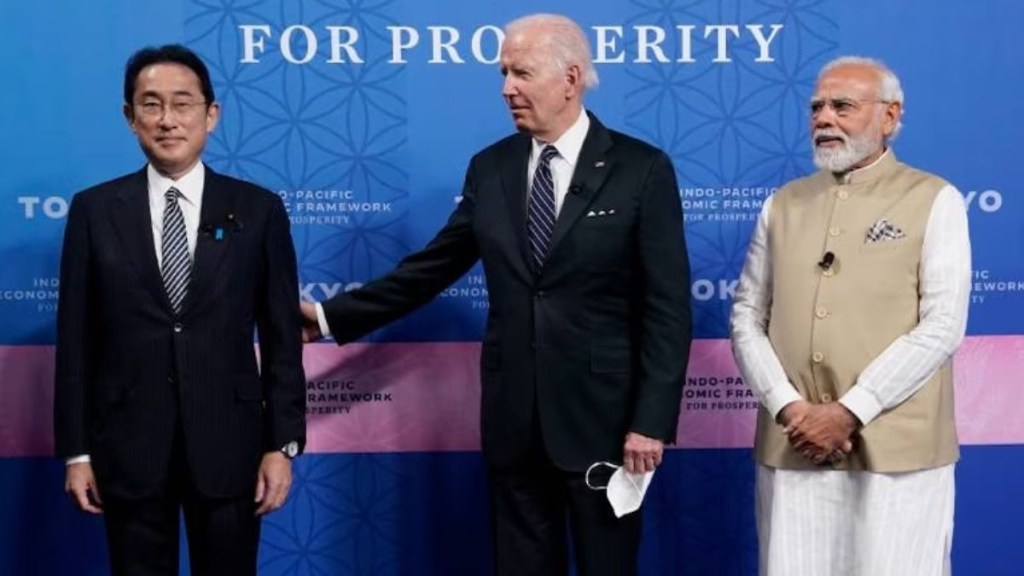By Amitendu Palit
The recently-concluded Asia-Pacific Economic Cooperation (APEC) Summit in San Francisco witnessed significant progress in negotiations on the Indo-Pacific Economic Framework for Prosperity (IPEF). The 14 members of the IPEF announced substantial conclusion of negotiations for Pillars 3 and 4—clean economy and fair economy—of the negotiating agenda. This follows the earlier conclusion and declaration of the legal text for the agreement for Pillar 2 on supply chains.
With the conclusion of negotiations for Pillars 3 and 4, the IPEF has delivered on most of its agenda. The legal text of the agreement on supply chains, finalised earlier, was signed by the trade ministers of the IPEF members at San Francisco.
On Pillars 3 and 4, the member nations will now work on preparing the legal texts and their subsequent processing. Once the legal scrubbing is over, the texts will be taken up by individual members for domestic implementations.
For many observers, however, the real ‘stuff’ of the IPEF is yet to be delivered. This is because negotiations are continuing for Pillar 1—the trade pillar—and no substantive conclusions have been announced for it.
The pillar is not about negotiating traditional market access issues. Instead, it is about dealing with very substantive and impactful issues for global trade. These include digital economy, labour, trade facilitation and agriculture.
Clearly, talks on the trade pillar are yet to conclude because moving forward on these issues is not easy. The pronounced heterogeneity among IPEF members, particularly in terms of the differences among them in outlooks, and domestic regulations, on most of the issues, is making progress on talks more difficult than those in the other pillars.
The non-conclusion of talks in the trade pillar is also an indication of the political sensitivities attached with it. The year 2024 will experience around 40 national elections in the world. Some prominent IPEF members, such as Indonesia, India, and the US, will be having their elections next year.
India hasn’t yet joined the trade pillar talks and will therefore not be too worried about the political implications of the talks on this. However, the implications could be significant for both Indonesia and the US.
Indonesia, as it is, might face significant difficulties in implementing the supply chain rules. Its policy to restrict export of critical minerals connects to its ideas to locate supply chains in critical minerals significantly within its own territory and jurisdiction. This might run contrary to the overall spirit of the supply chain agreement that encourages diversification among members.
On Pillar 1, the digital economy rules that encourage seamless and liberal flow of cross-border data also might come into conflict with Indonesia’s current regulations on personal data protection and the cross-border passage of such data.
For the US, Pillar 1 has several domestic implications. While not discussing traditional market access issues, such as tariffs and non-tariff barriers, the US expects digital economy rules in Pillar 1 to shape up in a way that enables its big tech to obtain and persist comparative advantages in IPEF.
However, at the same time, it also wants comparative advantages for its big tech to be secured in a way that restrains its tech companies from anti-competitive behaviour. This is quite evident after the US recently withdrew its earlier proposals on digital trade at the WTO that demanded free cross-border data flows discouraged data localization.
Some of the other regulatory expectations of the American stakeholders from the IPEF include institutionalising of labour standards in line
with the USTrade Representative’s (USTR’s) worker-centric approach to trade policy.
The sensitivities in Pillar 1 are major deterrents for the quick conclusion of decisions at a time when national elections are around the corner. Different IPEF members will be impacted in different ways by these sensitivities.
It is hardly surprising therefore that some IPEF members, including the US and Indonesia, and those who are likely to face elections within the next couple of years, will hesitate to commit to decisions without clearly understanding their political consequences.
What lies next for the IPEF? In a sense, the real challenge for the bloc will come now as various members work on establishing the decisions through their domestic processes.
Along with domestic ratifications, a very important task for IPEF members will be to take the announced decisions to the private sector for making them active stakeholders in the implementation of the decisions.
The IPEF’s supply chain and clean economy pillars visualise very active participation of enterprises and private investors. There is clearly much work that the members will need to do in this regard.
Notwithstanding what it has achieved in a rather short span of time, businesses are still confused over the character of the IPEF: whether it is selectively binding or entirely flexible; how widely applicable will its standards be; and how much can countries ‘pick and choose’ among its various provisions.
The next two years will determine the extent by which the IPEF experiment will be a path to follow for new-generation rules-based trade frameworks. Much will also depend on whether the US, even if there is a change in government, stays committed to the framework.
(The author is a senior research fellow and research lead (trade and economics) at the Institute of South Asian Studies, NUS. E-mail: isasap@nus.edu.sg. Views are personal)

